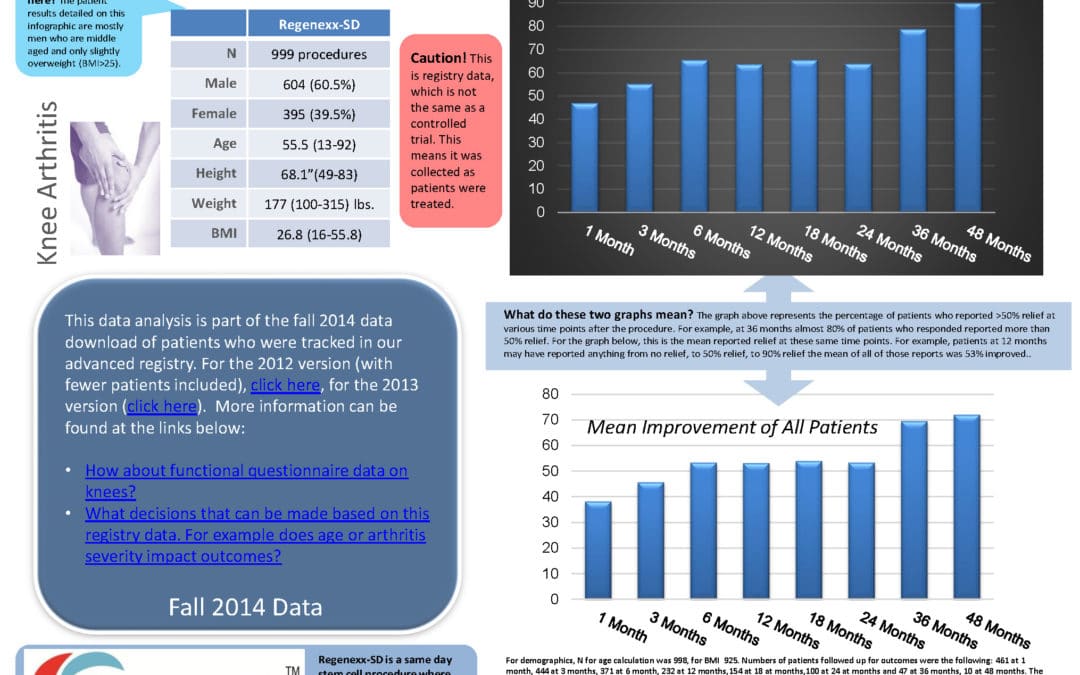What’s the latest in knee arthritis stem cell treatment research? Awhile back I published the pain/functional data for 2014. As you know, we publish data from our registry about once a year. Rather than sending a few questionnaires to patients, we have an advanced registry that tracks every patent treated. The most interesting thing about the percentage improvement data is that we now have it for Regenexx-SD out to four years. This begins to answer a common questions patients ask like, “How long will this last?”
First, a bit about these different metrics. The 2014 pain/functional inforgraphic discusses pain relief as measured by the common 1-10 pain score used by almost all medical providers today. That same inforgraphic also discusses changes in function. These are questionnaires that ask questions about walking, running, climbing, dressing, etc… Today’s release of 4 year data on knee arthritis patients treated with stem cells uses a percentage improvement metric. What’s that?
When I see patients in the clinic, they don’t automatically volunteer their change in pain score nor their detailed functional analysis of how the procedure helped or not. They do often say, “I feel X% better”. This single little number contains a lot of highly specific information that often outperforms the other two metrics (pain and function) in it’s brevity and specificity. For example, if someone’s pain drops from a 5 to a 2/10, were they talking about their knee pain or also including the pain in the shoulder they had? Also, if someone responds to a functional questionnaire and reports a better score, was that because their knee got better or did that chronic ankle issue you didn’t treat also improve? However, if I ask them what percentage change they feel from the knee stem cell cell injection we performed and they say, 70%, I just got a ton of data in one little number that’s highly specific to the procedure I performed.
So what does the new data show (see above-click on the picture to see a higher res copy)? High rates of percentage improvement through 4 years for most patients. This is really helpful for me as a physician when I discuss the duration of effect of our specific stem cell treatment protocol for knee arthritis. I can now say that our same day treatment has good longevity.
Having said that, this is registry data, so it’s not perfect. For example, we know that 7 of the 35 patients who were due to report at year 4 ended up with a knee replacement somewhere along the way. We also know that 8 had asked us to stop contacting them (usually due to their desire not to have to continue to fill out forms). Of the 20 left to report, only about half of those patients chose to respond. The good news is that when we have pushed long-term patients like these to respond in past efforts, the data we get back usually doesn’t significantly change the final outcome reports either way.
The upshot? What can I tell patients based on this new data? First, this isn’t a drug company style randomized controlled trial. Second, at least 20% of patients who were treated for knee arthritis by 4 years still needed a knee replacement despite the treatment. The great news is that the patients that responded report high rates of continued improvement at 4 years out from their injection. In summary, I had no idea what these numbers would show, as seeing patients back years later and what patients report to a registry staff are two different things. Having said that, I’m really happy to see that some of the patents we’re treating are getting very long-term relief!
See original post here: http://www.regenexx.com/2014/10/knee-arthritis-stem-cell-treatment-research/

